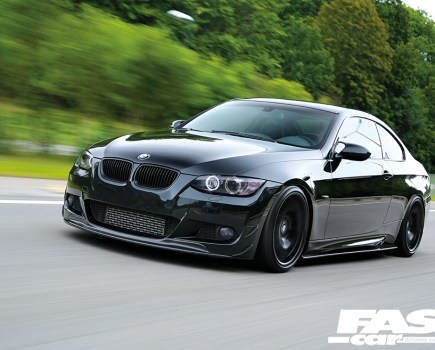Looking for an SUV that sits proudly on the luxurious end of the spectrum? Check out this Cadillac Escalade buyer’s guide for our expert used car advice.
The late 1990s were a watershed era for Cadillac. The company’s traditional buyers were aging out of the car-buying years and younger buyers looked at GM’s luxury brand as a joke compared to European luxury and performance cars. Cadillac started to reinvent itself for a new generation with the release of the CTS sedan in 2002, but before that happened, the brand made a much more important statement with the launch of its first-ever SUV, the 1999 Cadillac Escalade.
Jumping on the SUV bandwagon
The Escalade hit just as SUVs were becoming the go-to vehicle for celebrities and the wealthy. Lincoln had released the Navigator just the year before, and GMC had been ready to compete with Ford’s luxury brand with the first-ever Yukon Denali. Cadillac had to respond, and they did it by making the Escalade a step up in opulence from the Denali. But there was more than Ford driving this movement. Range Rover, Mercedes-Benz, and Lexus were all getting into the big luxury SUV business.
Cadillac found the answer to its problems in the Escalade, which is a French word meaning “to climb.” It has the same root word as an escalator. The rich and famous immediately adopted the new Cadillac, and as a result the Escalade became a must-have status symbol, with the name often shortened to “Slade” by its owners. Buyers tended to bling up their Escalades with gold badging and trim, and with ever-larger wheels that have now become standard equipment.
Cadillac sold 23,897 Escalades in that first year, and with few exceptions, sales numbers have trended up from there. Escalade sales topped 40,000 units in 2021 and 2022, and are on track to rise again in 2023.
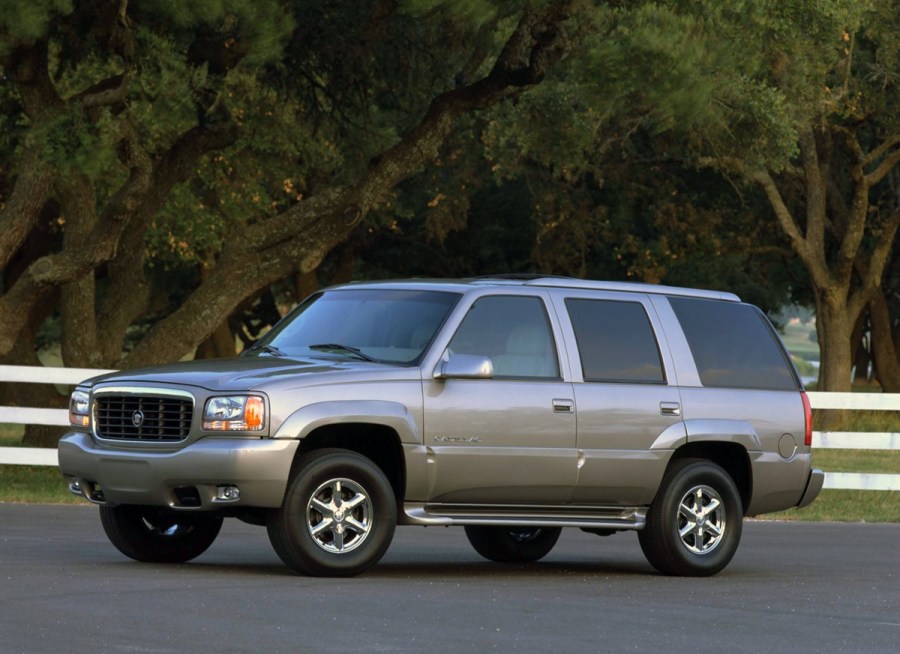
First-Generation Escalade (1999-2002)
Under the skin, the first-generation Escalade was a rebadged GMC Yukon, itself a clone of the Chevrolet Tahoe. All brand variants came with a 5.7-liter (350 CID) V8 engine rated at 255 horsepower and 330 pound-feet of torque, paired with a four-speed automatic transmission. Cadillac included All-Trac full-time all-wheel drive with every Escalade, while other brands had rear-drive as the basic driveline. On the outside, the first Escalades did little more than replace the GMC badges with Cadillac insignia, but the interior was what made an Escalade worth its $46,525 price tag.
An Escalade interior came with real wood trim everywhere you might touch, including on the steering wheel, as well as perforated and heated leather seating in both front and second rows. Everything else on an Escalade was already to top tier of GM equipment. 16-inch chromed wheels were impressive in that day, and tunes were provided by a seven-speaker Bose sound system with a big subwoofer and a 6-disc CD changer. An in-car cell phone was optional.
From the beginning, the Escalade was produced at Arlington, Texas. GM made the Escalade on its initial platform until the end of the 2000 model year, while GMC and Chevrolet switched to a newer platform for the 2000 model year. Cadillac technically skipped the 2001 model year by releasing the 2002 Escalade in January of 2001, taking advantage of a quirk in American model year law that allows manufacturers to sell the next model year at any time in the preceding year.
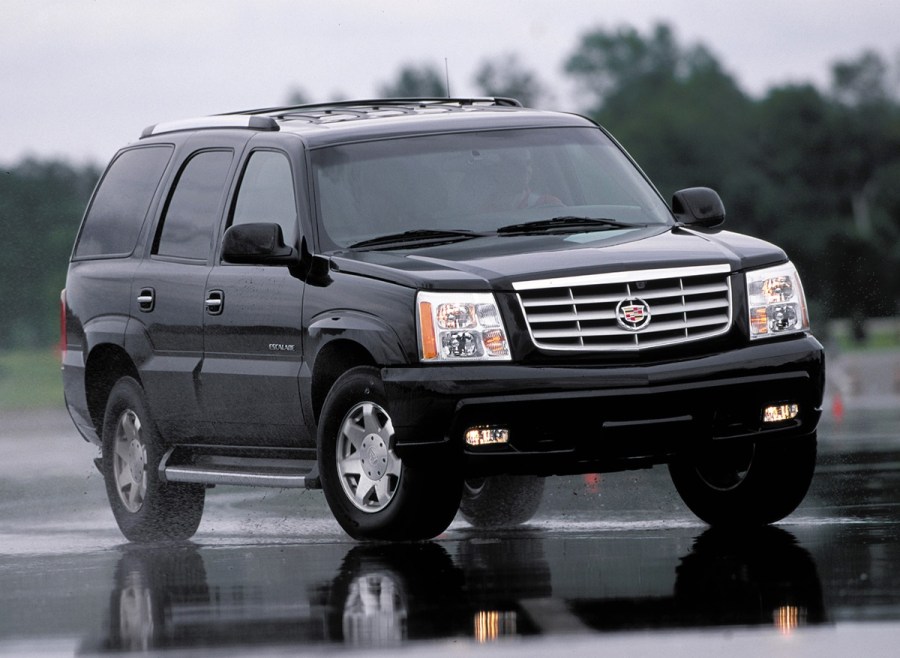
Second-Generation Escalade (2002-2006)
The new Escalade for 2002 made several critical improvements and started to differentiate itself more from the GMC Yukon Denali. Following the lead of the CTS sedan, the new Escalade used sharper cut lines on the hood and front area, while keeping the standard GM shape from the windshield rearward.
One big change was that rear-wheel drive was the basic driveline layout, though all-wheel drive remained available as an option. Also new was the LM7 5.3-liter V8 engine on rear-drive models, rated at 285 horsepower, which represented a solid power gain over the older L31 350 V8. However, ordering AWD meant an engine upgrade to the 6.0-liter LQ9 V8 engine, which produced 345 horsepower and 380 pound-feet. Both options utilized four-speed automatic transmissions.
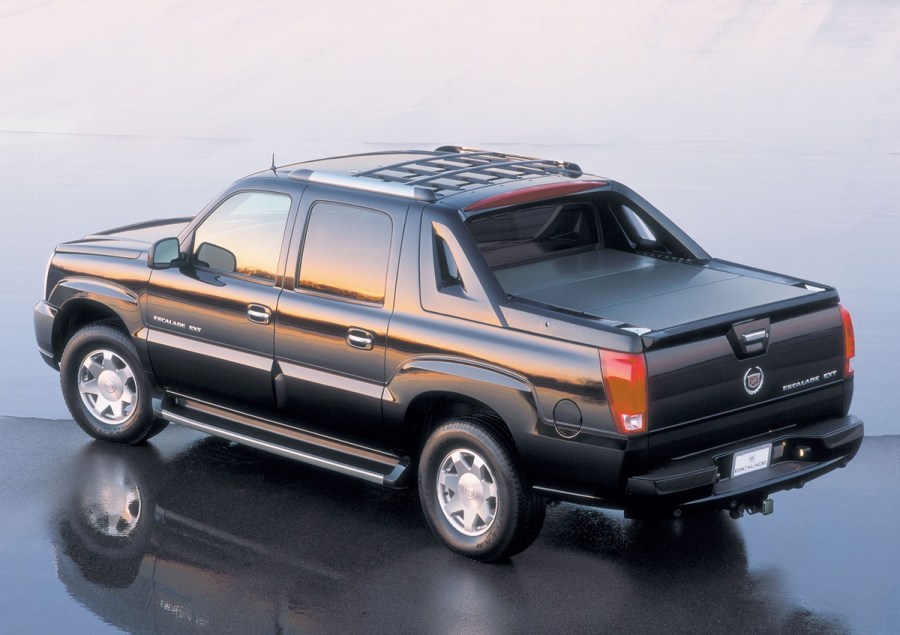
Cadillac EXT
Several months into the 2002 model year, though still in calendar 2001, Cadillac released the Escalade EXT. Based on the Chevrolet Avalanche, this was a “sport utility truck” with a short (5.25 feet) truck bed in place of the third row of seats and rear cargo area. There’s a bottom-hinged door at the back of the cab that allows you to place longer items in the bed extending into the cab. All Escalade EXT models were equipped with all-wheel drive, and the 6.0-liter engine, and all were made in Silao, Mexico.
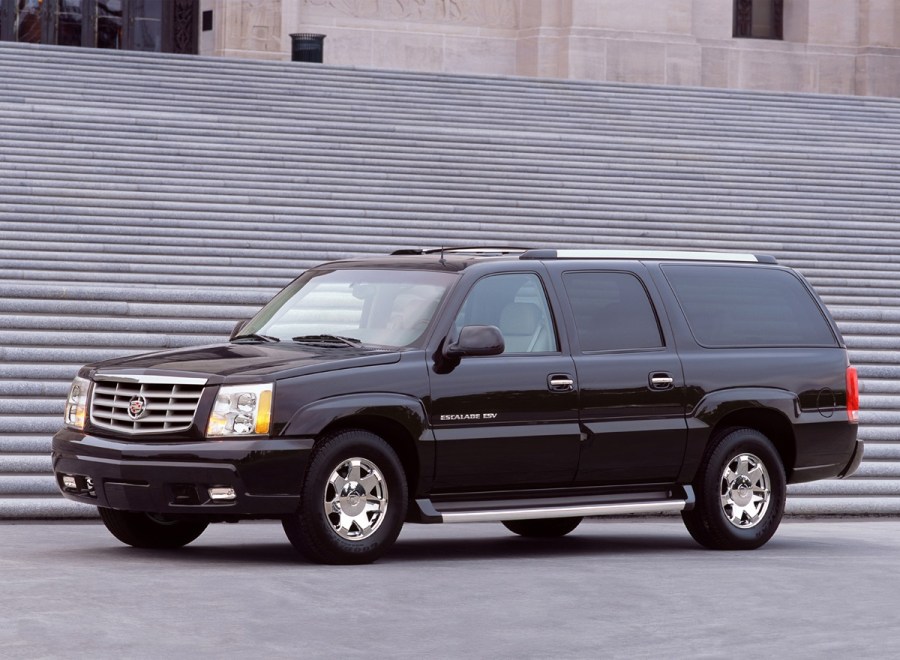
Cadillac ESV
After releasing the EXT, Cadillac followed up on consumer requests with an extended-wheelbase version of the Escalade corresponding to the GMC Yukon XL and Chevrolet Suburban. The 2003 Escalade ESV (Escalade Stretch Vehicle) was almost 11 inches longer with the extra space allocated to the third row seats and cargo area. Cargo capacity on an ESV was 120 cubic feet, compared to 94 cubic feet in a standard Escalade. Again, the ESV came only with the 6.0-liter engine and AWD, and was made in Silao.
Technology was moving quickly in this era, and as the model years progressed Cadillac offered Escalade buyers features such as GPS navigation, better stability control, rear seat DVD entertainment systems, and upgraded audio options. Escalade models were always top-of-the-line in terms of standard and optional equipment. Prices also rose quickly, reaching about $50,000 for a standard Escalade and $71,000 for an Escalade ESV by 2004.
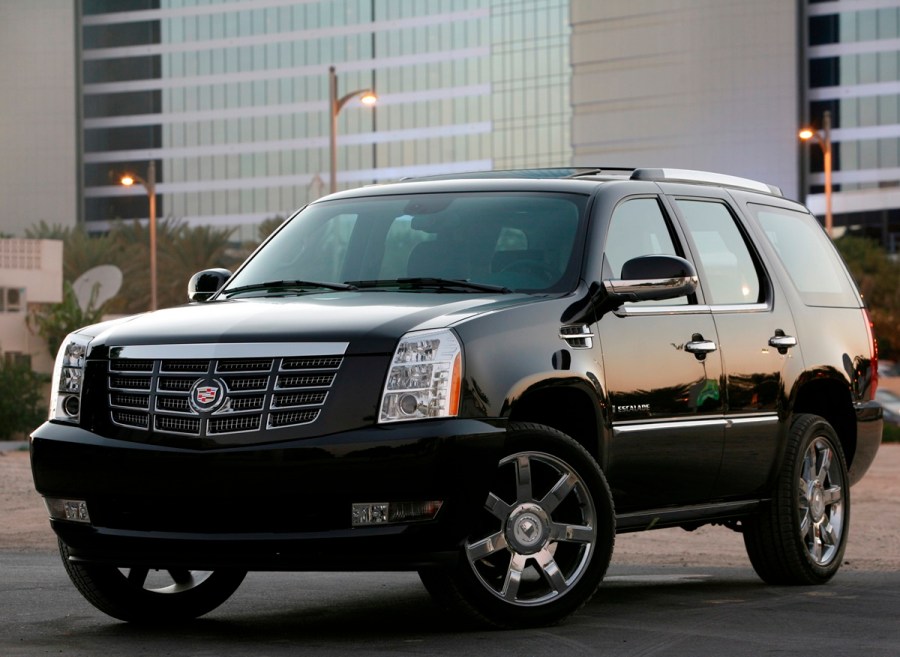
Third-Generation Escalade (2007-2014)
By its second redesign, the Escalade was among the best-selling Cadillacs on the market, and a critical image-maker for the brand. Cadillac further differentiated the Escalade with vertically stacked lights and angular bodywork from bumper to bumper. The standard wheelbase Escalade was again supplemented with the long-wheelbase ESV and the pseudo-pickup Escalade EXT produced through the 2013 model year.
In this generation, Cadillac upgraded the Escalade to the 6.2-liter Vortec L92 V8 engine. The new engine was rated at 403 horsepower and 417 pound-feet of torque. Power was passed through a 6-speed automatic transmission to the rear wheels or all wheels.
Luxury features kept pace with the times, including heated leather upholstery in the first two rows, wood and leather-wrapped steering wheel, Bluetooth phone support, six-disc CD changer, remote engine start, and a power lift-gate. The optional Platinum package included a second-row DVD entertainment system, GMS navigation, heated and cooled cup holders, backup camera, ventilation on the front seats, upgraded leather, and retracting running boards.
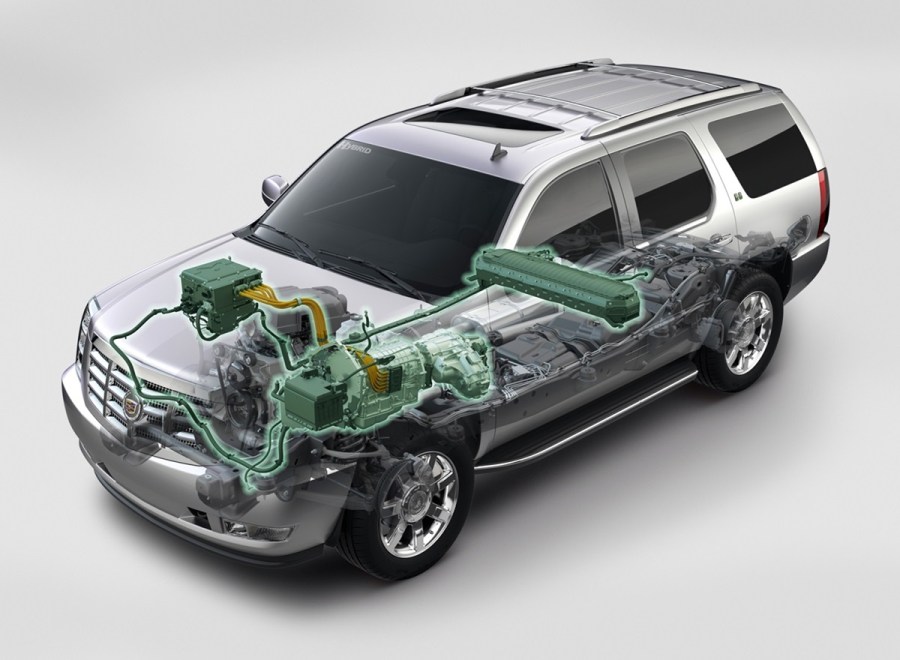
Hybrid powertrains
Alternative fuels were becoming a hot topic in this era, and in 2009 Cadillac offered the Escalade with E85 flex-fuel capability. This model could run on standard pump gasoline (10% ethanol in the United States) or mixtures up to 85% ethanol. E85 fuel was sold through its own pumps, but never gained popularity because it was more expensive than straight pump gas and yielded worse fuel economy. Most buyers of E85-capable vehicles rarely used the optional fuel.
Cadillac also followed its sister brands in 2009 by offering the Escalade with a hybrid driveline. The Escalade Hybrid uses a 6.0-liter V8 engine with hybrid electric motor, paired with continuously variable transmission driving the rear wheels only. The hybrid Escalade was initially popular, claiming up to a 20% take rate. Power was not bad at about 379 total system horsepower, so the hybrid wasn’t materially slower than other models, but it was more expensive, and when the novelty wore off, sales declined and the Escalade Hybrid was terminated along with the EXT at the end of the 2013 model year.
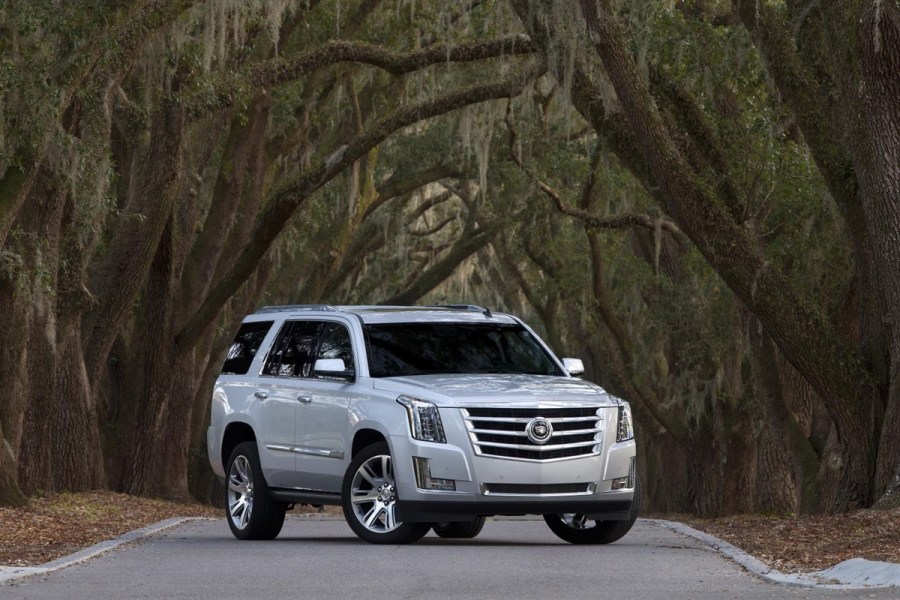
Fourth-Generation Escalade (2015-2020)
The fourth redesign re-emphasized Escalade’s difference from GMC and Chevrolet, with a much more imposing visual presence. Reduced to its fundamental short and long wheelbase options and without hybrid or flex-fuel options, the fourth-generation Escalade truly knows what it is and how to be a luxury SUV.
The fourth-gen Escalade used the new EcoTec V8 engine, still at 6.2 liters, but now making 420 horsepower and 460 pound-feet of torque. The transmission was still a six-speed automatic, with buyer’s choice of rear-drive or AWD through 2017, and then the new Allison 10-speed automatic for 2018-2020. The new package dropped the 0-60 time for the Escalade to 5.96 seconds and the Escalade ESV to 5.98 seconds, which was especially impressive for an SUV of its size. The engine also featured automatic cylinder deactivation when full power wasn’t needed.
Cabin equipment
Features still kept pace with the times, moving to full LED lighting, including the thin vertical LED taillights that had become a signature for the Escalade. Wheel size grew to 20 and then 22 inches as standard equipment. At this time, all GM vehicles had started coming with a 4G/LTE data connection as standard, and the Escalade augmented that with a 16-speaker Bose Centerpoint audio system.
Blu-Ray and DVD entertainment remained optional for second-row passengers. Also optional was the new generation of safety and driver assistance features like blind spot monitoring, forward collision alert, lane departure warning, automatic high beams, and the haptic vibrating seat alerts. The Driver Awareness Package included all that plus full-speed-range adaptive cruise control, front and rear automatic braking, automatic collision mitigation, and seat belt tightening. Later years in this generation brought standard lane keeping assistance, active parking assist, 360-degree backup camera, and a camera-based rear-view mirror.
Quality was also rising in this period, and Cadillac claimed several initial quality and reliability awards with this generation of Escalade. Pricing in this generation was about $75,000 for the basic Escalade and $80,000 for Escalade ESV.
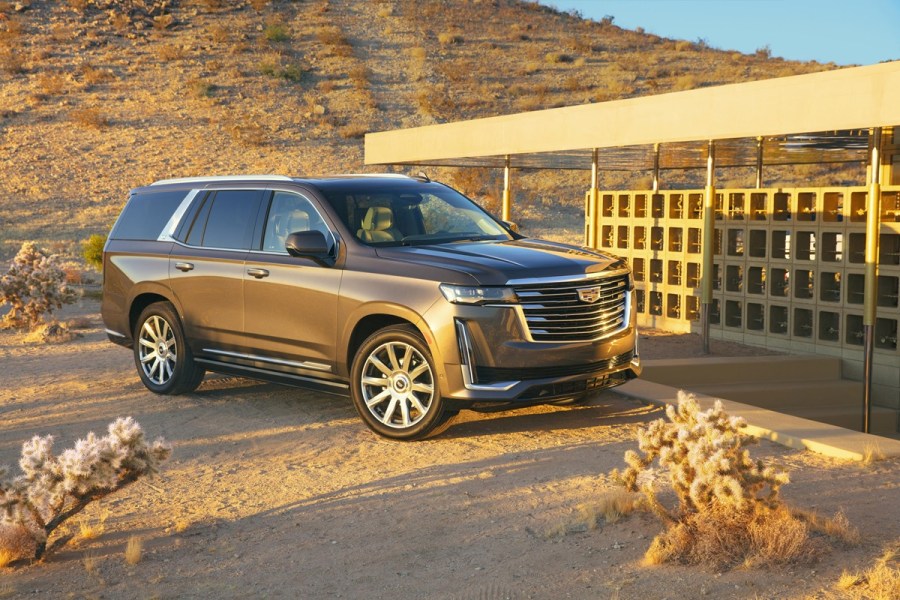
Fifth-Generation Escalade (2021-2024)
For what was essentially its 20th anniversary, the Escalade got another redesign and a new platform. The biggest news in this generation is the change from a traditional solid rear axle truck chassis design to independent rear suspension. This makes the fifth-generation Escalade ride and drive much more smoothly than any prior generation.
The technology story of the Escalade took another quantum leap in this generation with the industry-first curved touchscreen stretching from the driver’s side to the center of the dashboard, offering 38 inches diagonal measurement for the driver information and infotainment displays. Infotainment alone accounts for 16.9 inches of the display. That was the medium to allow the addition of the optional Augmented Reality-enabled navigation, which uses live street views from the forward-facing camera, overlaid with directional instructions to enhance the audible instructions.
The 2021 Escalade also received Cadillac’s Super Cruise technology. This feature allows hands-free adaptive cruise control driving on more than 200,000 miles of roadway in the United States and Canada, using LiDAR map data, high-precision GPS, a state-of-the-art driver attention system and a network of cameras and radar sensors. Escalade Super Cruise is further enhanced with automated lane change, allowing the driver to direct the system to perform a lane change using the turn signal to indicate the direction of the desired move.
Mechanical updates
The rear suspension change also had benefits inside the Escalade, giving third-row passengers 10 additional inches of legroom, while also improving cargo capacity. However, the primary benefit was in ride and handling, which became much more like a smaller unibody SUV. Cadillac augmented this with optional magnetic ride control and an adaptive air-ride suspension that allows several inches of vertical adjustment for ease of access and better handling at speed (lowered) or off-road (raised).
Under the hood, Cadillac offered another first. Buyers could purchase the now-traditional 6.2-liter Ecotec V8 engine at 420 horsepower/460 pound-feet of torque, or choose the new 3.0-liter Duramax inline six-cylinder turbo-diesel engine with 460 pound-feet of torque. In both cases, the 10-speed automatic transmission standard, and buyers can choose between rear-wheel or all-wheel drive.
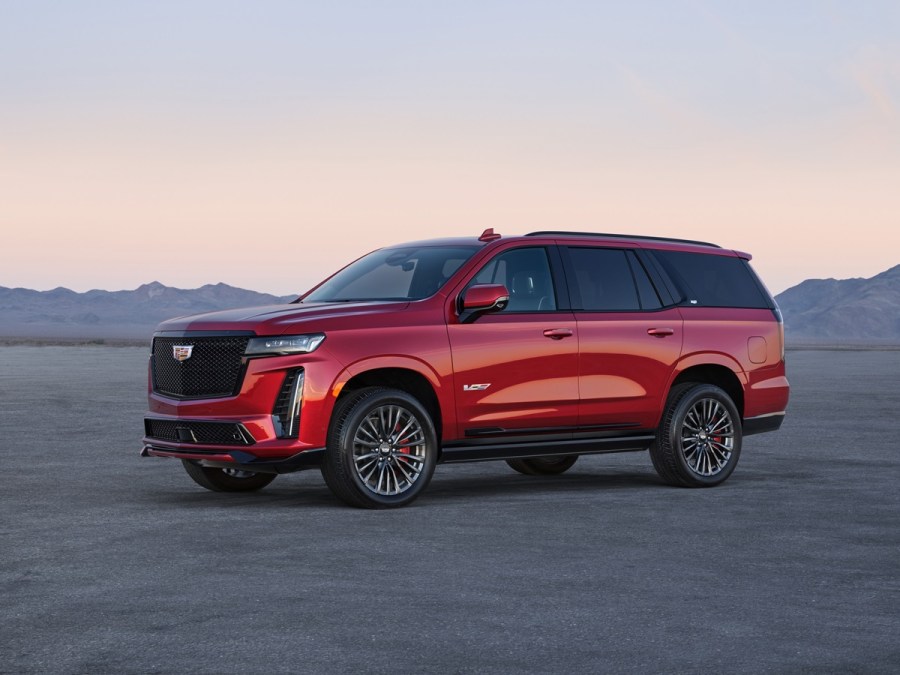
V-Series
For 2023, Cadillac added the Escalade-V, part of its V-Series performance lineup. This special Escalade is delivered with a supercharged version of the 6.2-liter V-8 engine rated at 682 horsepower and 653 lb-ft of torque. Standard performance elements include the usual 10-speed automatic transmission, but specially calibrated for Escalade-V, full-time active all-wheel-drive system and exclusive suspension hardware and software calibrations. There are also huge Brembo brakes, as well as the magnetic ride and air suspension. An Escalade-V ESV version is also available. The 0-60 dash is accomplished in under 4.4 seconds. This version of the Escalade retails for $149,195.
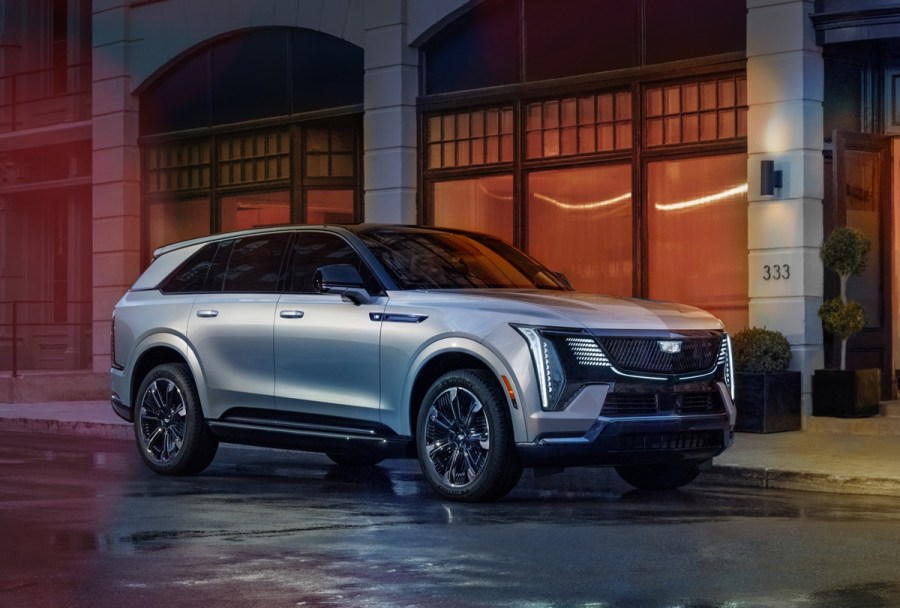
The Next Generation 2025 Cadillac Escalade IQ
In the middle of the 2020s, it stands to reason that Cadillac would expand its all-electric lineup to include the Escalade, and the 2025 Escalade IQ has been announced and unveiled. The new EV version will join the gas or diesel-fueled Escalades with about 450 miles of range on a charge and up to 750 horsepower and 785 pound-feet of torque on tap. The IQ will be able to power your home in a blackout and will tow up to 8,000 pounds of trailer. Of course, Super Cruise and all the other tech goodies are included, and there’s a 55-inch curved screen for all your displays. Wheels are 24 inches in diameter, and shod with 35-inch tires.
Like the Ultium-based GMC Hummer which shares it platform, the Escalade IQ will offer four-wheel steering including the ability to move diagonally, called “Arrival Mode.” There’s also a “Low Ride” mode that enables low-speed movement with the air suspension completely compressed.
There’s more, of course, a lot more. Pricing on the Escalade IQ is expected to start at about $130,000 when sales begin sometime in 2024.
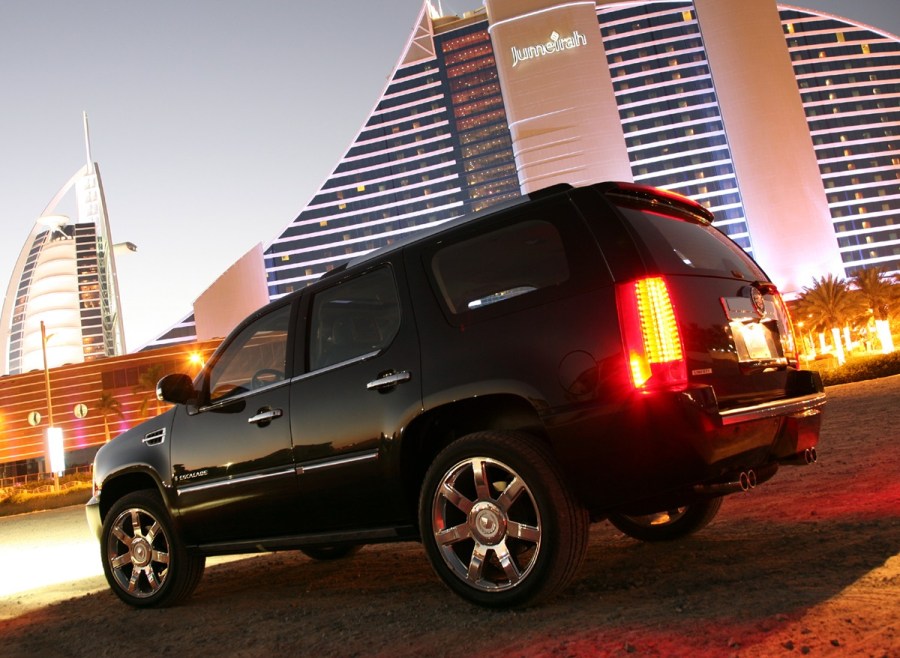
Reliability and Safety
The reliability and safety ratings of the Escalade have steadily increased over its production lifetime. Early models had comparatively poor safety ratings, sometimes ranking among the least-safe full-size SUVs on the market. The Escalade’s traditional body-on-frame design could not compete well with newer crumple-zone unibody designs.
Generally speaking, the newer the Escalade, the better it is in terms of both reliability and safety. The 6.2-liter Ecotec V8 has been essentially unchanged since its introduction and it is a proven reliable engine. Same with the Allison 10-speed transmission, which is not only shared between GM brands but also with Ford products.
The Escalade Hybrid will pose a particular challenge for buyers on the used market because of its low production numbers and unique continuously variable transmission. This model is best avoided for most purposes, if you can even find one for sale.
In general, if you can choose between the first year of a given generation and later years, pick the later ones. Most Escalade redesigns involved a major platform change, and with the pace of technology, it’s generally smart to avoid first-year vehicles after an update. Here again, the newer the better.
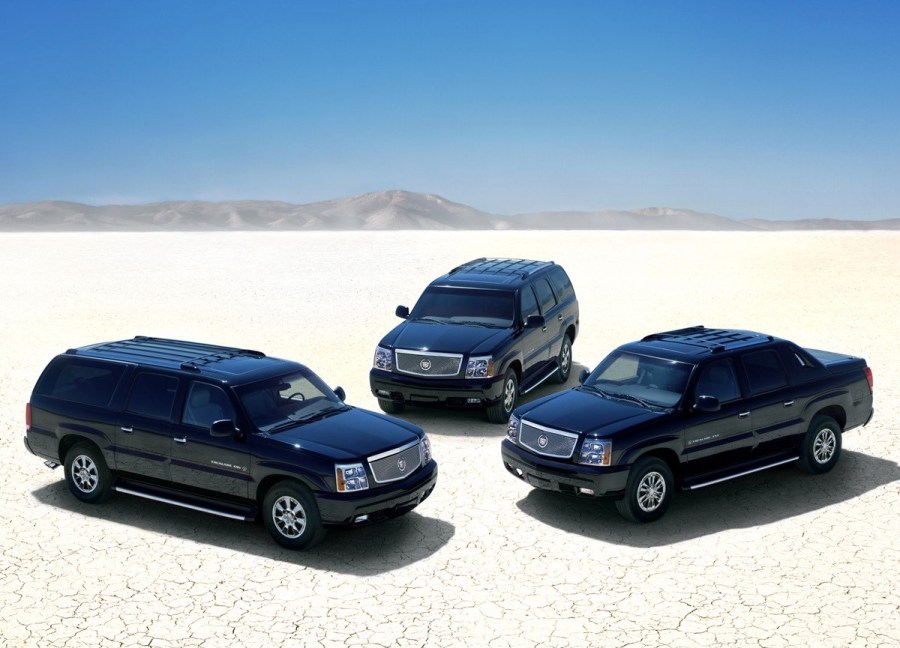
Escalade Timeline
1998: All-new 1999 Escalade unveiled
1999: First year of Escalade with AWD
2001: Second-generation Escalade introduced
2002: Long-Wheelbase Escalade ESV introduced
2003: First year of the truck-bed Escalade EXT
2007: Third-generation Escalade with 6.2-liter Vortec engine
2009: Escalade hybrid introduced
2009: Escalade modified to accept E85 flex-fuel
2013: End of production for Escalade Hybrid and Escalade EXT
2015: Fourth-generation Escalade introduced
2018: First 10-speed automatic
2021: Fifth-generation Escalade introduced with independent rear suspension
2021: Duramax turbo-diesel engine introduced
2023: Escalade-V introduced
2024: Escalade IQ scheduled for production
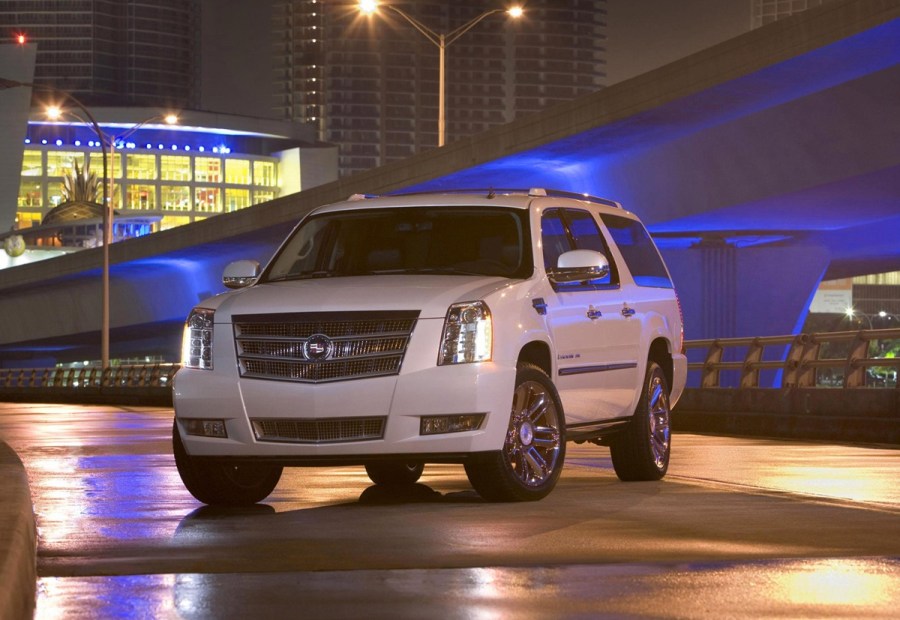
How much should I pay for an Escalade?
As with any used SUV purchase, mileage, condition, and the vehicle’s individual history will be paramount in getting a good deal on a reliable and enjoyable vehicle. Within broad bounds, here’s how pricing is shaking out right now in the US. If you’re in the UK, you’ll have to take into account potential import costs too, as Escalades were never officially exported there from North America.
First-generation
You should be able to find a high-quality example with less than 100,000 miles on the odometer for about $15,000-$20,000. Higher mileage and questionable history such as crash damage or other issues should drive that price point downward significantly. However, at this age, only the really good ones are still outside the junkyard fence.
Second-generation
The 2002-2006 Escalade, including the EXT, sells for about the same price range as the first generation, which is $15,000-$2000 for a very good low-miles example. As a rule, the standard Escalade is worth a bit more than a comparable EXT. The top low-miles examples (under 50K miles) may reach as high as $30,000, but do bargain aggressively and look for the Platinum trim level. More conventional used car examples with high miles should be available well under $10,000.
Third-generation
You might be able to find the 2007-2014 generation of Escalade for as low as $20,000 in good, very-low-miles condition, but be prepared to spend up to $35,000 or even $40,0000 on the best examples. As the Escalade really grew into its identity, this generation has aged well and begins to offer modern tech and amenities in the later years of the generation. These are also the last of the EXT body style, if that’s what you want. Still, if you’re shopping the general higher-miles used car market, these are available in the $15,000 range.
Fourth-generation
Prices start to rise dramatically in the 2015-2020 generation. The basic Escalade should be available in the $30,000 range, but with the EcoTec engine, aftermarket companies like Hennessey and Callaway began raising the performance of the Escalade along with their other GM efforts, and those hot rods typically sell north of $50,000. Conventional Escalades of this era sell on the standard used car market for about $30,000 to $40,000, depending on the specifics.
Fifth-generation
For the most part, these Escalades are not yet available on the pre-owned market. Collectors are paying MSRP or more for the Escalade-V, but even the lease-return Escalades have not yet hit the market. Expect to pay close to retail on any Escalade in this generation, with prices starting around $80,000. Do look closely at the title and CARFAX report, and ask why the vehicle is for sale.



